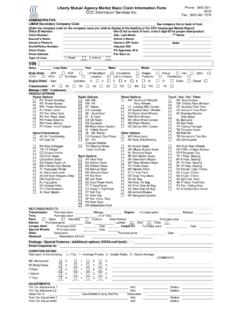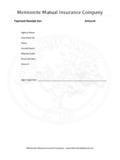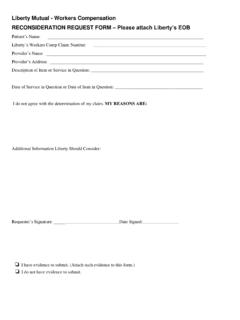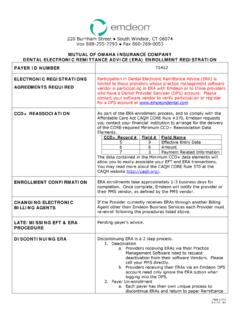Transcription of Parallel Line Mutual Coupling Compensation - …
1 Parallel line Mutual Coupling Compensation in the L-PRO Transmission line Protection Relay Introduction As power systems expand, extra transmission lines are needed. In many places, population density has put restrictions on the availability of transmission line right of ways, therefore multiple transmission lines are put on each transmission line tower. As a result, Mutual Coupling effects between circuits can influence impedance measurements performed by impedance-based distance relays that are often used to protect these lines during faults.
2 Bringing the zero sequence current from a Parallel line into a distance relay used to protect a power line , can be used to correct the effect of Mutual Coupling from other Parallel lines. This document describes how this correction can be done using the ERLP hase L-PRO relay. Description line 2 line 1 Bus ABus BSYSTEMASYSTEMB21N21 NFigure 1 Parallel line ApplicationLine 3( Protected line ) ( Parallel line )( Parallel line ) Figure 1: a line is shown using L-PRO distance line relays. Two Parallel lines are also shown. In this application an L-PRO relay is applied at each end of line 1, with lines 2 and 3 in Parallel .
3 The effect of the Parallel lines is to produce a zero sequence Mutual Coupling effect between the three lines. Discussion The issue of Mutual Compensation relates to the setting reach that a ground distance relay encounters during ground faults when Parallel lines are present. Distance relays used to measure phase phase or three-phase impedances do not use zero sequence quantities, therefore are not bothered by zero sequence Mutual Compensation . Our discussion will start at this level. The reader can also find many references on this topic from past papers and presentations.
4 To understand why Mutual Coupling is important, let s look at the fundamental issues. To begin with, most ground distance relays use the line positive sequence impedance to determine their reach. This method is used for convenience so that the phase distance relays and the ground distance relays can be set to the same point on the protected line . Ground Distance Relay Reach with No Parallel Lines For a single line with no Parallel lines present, the positive sequence reach for the ground distance relay is determined by: Z positive sequence = ____Vph-neutral Iphase + 3koIo Where ko = Zo Z1 3Z1 The parameter ko is called the self Compensation factor and involves the difference and the ratios between the line positive and zero sequence impedances.
5 The L-PRO offliner program calculates the ko factor magnitude and phase angle automatically, based on the line Z1 and Zo. Since Z1 and Z2 are vectors, ko is also a vector with magnitude and angle. The offliner setting software allows the user to override the default setting of ko. If the application requires a different value of ko, the default value can be overridden. A typical setting for a zone 1 distance relay is 80 to 85 % of the line positive sequence impedance for both phase and for ground faults. The zone 1 setting is made so that it will not overreach the end of the protected line since zone 1 is usually a direct tripping function.
6 Some margin in the setting reach must be provided to allow for current, voltage transformer errors and line impedance variations. 21N 1,2,3,4= ___Vph- nIph + 3 KoIoGROUND DISTANCE REACH( Including Fault Location ) ( Parallel line 2 ) 21N 1,2, Fault Location= ___Vph-nIph+3 KoIo+3Km1Io1( Parallel line 3 ) 21N 1,2 = _____Vph-n_____Fault Loc. Iph + 3 KoIo+3Km1Io1+3Km2Io2Km1=Zmo/3Zl1Km2=Zmo/ 3Zl11-21-3( Protected line 1 ) Figure 2: Offliner setting of Mutual Coupling .
7 Ground Distance Relay Reach with One or Two Parallel Lines In Figure 2, it can be seen that L-PRO is equipped with the ability to bring in AC currents from up to two Parallel lines into Inputs I3 and I4. When Parallel line (s) are present, the ground distance reach equation becomes: Z positive sequence = _____Vph-neutral_____ Iphase + 3koIo + 3km1Io + 3km2Io For the case with one Parallel line , only the 3km1Io is added to the single line equation, and 3km2Io is added if two Parallel lines are encountered.
8 In this equation, Km1 = Zmo(1-2)/ 3Z11, which means the Mutual factor Km1 is the zero sequence Mutual impedance between the protected line and the first Parallel line ( Zmo ( 1-2 ) ) divided by 3 times the positive sequence impedance of the protected line 1. The second term in the denominator of the equation would be applied if a 3rd Parallel line is encountered. An interesting observation can be made in that if sources at each end of the lines are equal, a ground fault in the middle of the protected line will result in zero sequence currents in the Parallel lines of zero, effectively reducing the equation to one where no Compensation is applied.
9 The L-PRO relay has AC current inputs of I3 and I4 that can take in 3 sets of currents each ( IA3, IB3 & IC3 and IA4,IB4 &IC4 ). If all three currents are connected to the relay, the 3Io current will be calculated by the relay and all the phase currents will be included in the fault recordings. On the other hand, if only 3Io ( ground current ) from a Parallel line is brought into the L-PRO, this current will be used. With the single 3Io current from a Parallel line , this current can be connected to any phase of the I3 input for line 2 and any phase of the I4 input for line 3.
10 When Mutual Compensation is elected in the settings, the 21N-1, 21N-2 and the phase to ground fault location is affected by the Mutual Compensation factor(s). Bus ABus BFigure 3 Parallel line Application( 3 Phase Currents From Parallel line ) line 1( Protected line ).. Ib IaI3c I3b 2( Parallel line ) L-PRO For line 1 Figure 3: Parallel line application. Example of how 3 phase connection of currents can be connected to L-PRO. In Figure 3, an L-PRO is shown protecting line 1 at Bus A, and current from Parallel line 2 is brought into the L-PRO input currents I 3.






